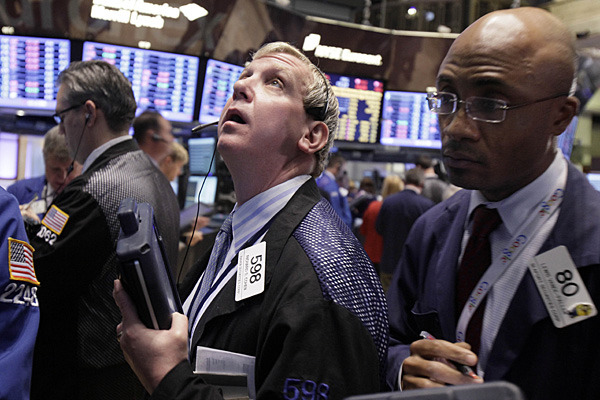On Wednesday, Shares of American Airlines Group Inc. (NASDAQ:AAL), lost -10.01% to $43.06.
Shares of major U.S. airlines fell as much as 10 percent Wednesday as investors worried that the carriers might add too many flights and cannibalize their profit margins, according to AP.
Airlines have earned record profits partly by limiting capacity, which props up fares, and by adding new fees and raising the price of old ones. Investors fear that the airlines are losing that discipline and adding too many seats for the traveling public to fill at current fares — that could lead to lower prices and thinner profit margins. AP Reports.
American Airlines Group Inc., through its auxiliaries, operates in the airline industry. As of December 31, 2014, the company operated 983 mainline jets, in addition to 566 regional aircrafts through regional airline auxiliaries and third-party regional carriers. It serves 339 destinations in 54 countries.
Shares of Applied Materials, Inc. (NASDAQ:AMAT), declined -0.40% to $19.91, during its last trading session.
On May 14, Applied Materials, stated results for its second quarter ended April 26, 2015.
Second quarter orders were $2.52 billion, up 11 percent sequentially and down 4 percent year over year. Net sales were $2.44 billion, up 4 percent sequentially and up 4 percent year over year.
“Applied posted our highest quarterly revenue in the past three years and earnings near the top of our guidance range,” said Gary Dickerson, president and CEO. “These results demonstrate that Applied is delivering the enabling products and services our customers need as they transition complex new devices into volume production.”
Business Outlook
For the third quarter of fiscal 2015, Applied anticipates net sales to be in the range of up 2 percent to up 6 percent from the previous quarter, the midpoint of which would be up 12 percent year over year. Non-GAAP adjusted diluted EPS is predictable to be in the range of $0.31 to $0.35, the midpoint of which would be up 18 percent year over year.
Applied Materials, Inc. provides manufacturing equipment, services, and software to the semiconductor, flat panel display, solar photovoltaic (PV), and related industries worldwide. The company’s Silicon Systems Group segment develops, manufactures, and sells a range of manufacturing equipment used to fabricate semiconductor chips or integrated circuits.
At the end of Wednesday’s trade, Shares of The Wendy’s Company (NASDAQ:WEN), gained 1.67% to $11.57, hitting its highest level.
The Wendy’s Company, declared that it has reached a purchase agreement under which one of its indirect, special purpose auxiliaries has agreed to issue and sell $875 million of its Series 2015-1 3.371% Fixed Rate Senior Secured Notes, Class A-2-I, $900 million of its Series 2015-1 4.080% Fixed Rate Senior Secured Notes, Class A-2-II, and $500 million of its Series 2015-1 4.497% Fixed Rate Senior Secured Notes, Class A-2-III. Interest payments on the Notes are payable on a quarterly basis. The legal final maturity date of the Notes is in June of 2045, but, unless earlier prepaid to the extent permitted under the indenture that will govern the Notes, the anticipated repayment dates of the Class A-2-I Notes, the Class A-2-II Notes and the Class A-2-III Notes will be 4.25, 7 and 10 years, respectively. The Notes are predictable to be issued by the Master Issuer in a privately placed securitization transaction.
The Master Issuer also intends to enter into a purchase agreement under which it will issue $150 million Series 2015-1 Class A-1 Notes, which will allow the Master Issuer to borrow amounts from time to time on a revolving basis.
The closing of the sale of the Notes is predictable to occur on June 1, 2015, subject to satisfaction of various closing conditions.
The Wendy’s Company, through its auxiliaries, owns and franchises Wendy’s restaurant system. The company is involved in operating, developing, and franchising a system of quick-service restaurants. As of December 28, 2014, its restaurant system comprised of 6,515 restaurants, of which about 957 were company-operated restaurants in the United States and 27 foreign countries.
Finally, eBay Inc. (NASDAQ:EBAY), ended its last trade with -0.17% loss, and closed at $59.15.
eBay, which is in the process of separating eBay and PayPal to create two independent publicly traded companies, declared the directors who will serve on the boards of each standalone company following the separation. Each director was re-elected to the eBay Inc. Board at the 2015 Annual Meeting of Stockholders in May 2015.
As formerly declared, the new eBay Board will be chaired by current eBay Inc. director Thomas Tierney. Following the separation, the eBay Board of Directors will comprise of the following additional directors:
- Fred Anderson— Has served as a director of eBay since July 2003. Anderson has been a Managing Director of Elevation Partners, a private equity firm focused on the media and entertainment industry, since July 2004.
- Edward Barnholt— Has served as a director of eBay since April 2005. Barnholt served as President and Chief Executive Officer of Agilent Technologies, Inc., a measurement company, from May 1999 until his retirement in March 2005.
- Anthony Bates— Has served as a director of eBay since March 2015. Bates has served as President of GoPro, Inc. since June 2014.
- Bonnie Hammer— Has served as a director of eBay since January 2015. Hammer has been Chairman of NBCUniversal Cable Entertainment, a division of NBCUniversal, since November 2010.
- Kathleen Mitic— Has served as a director of eBay since September 2011. Mitic is the Founder and CEO of Sitch Inc. (formerly Three Koi Labs Inc.), a mobile start-up company formed in August 2012.
eBay Inc. operates as a technology company that enables commerce and payments on behalf of users, merchants, retailers, and brands of various sizes in the United States and internationally. It operates in three segments: Marketplaces, Payments, and Enterprise.
DISCLAIMER:
This article is published by www.wsnewspublishers.com. The Content included in this article is just for informational purposes only. All information used in this article is believed to be from reliable sources, but we make no representations or warranties of any kind, express or implied, about the completeness, accuracy, or reliability with respect to this article.
All visitors are advised to conduct their own independent research into individual stocks before making a purchase decision.
Information contained in this article contains forward-looking information within the meaning of Section 27A of the Securities Act of 1933 and Section 21E of the Securities Exchange Act of 1934, counting statements regarding the predictable continual growth of the market for the corporation’s products, the corporation’s ability to fund its capital requirement in the near term and in the long term; pricing pressures; etc.
Any statements that express or involve discussions with respect to predictions, expectations, beliefs, plans, projections, objectives, aims, assumptions, or future events or performance may be forward looking statements. Forward-looking statements are based on expectations, estimates, and projections at the time the statements are made that involve a number of risks and uncertainties which could cause actual results or events to differ materially from those presently anticipated. Forward looking statements may be identified through the use of such words as expects, will, anticipates, estimates, believes, or by statements indicating certain actions may, could, should/might occur.



